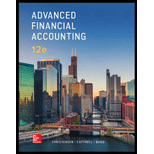
Advanced Financial Accounting
12th Edition
ISBN: 9781259916977
Author: Christensen, Theodore E., COTTRELL, David M., Budd, Cassy
Publisher: Mcgraw-hill Education,
expand_more
expand_more
format_list_bulleted
Concept explainers
Question
Chapter 6, Problem 6.3.1E
To determine
Concept Introduction:
Intercompany transactions:
Consolidated financial statements are prepared by a parent company to consolidate the assets and liabilities of the parent and its subsidiaries. There may be some transactions between these companies which are called intercompany transactions.
To choose: the amount of sales to be reported in the consolidated income statement.
Expert Solution & Answer
Want to see the full answer?
Check out a sample textbook solution
Students have asked these similar questions
Please solve this General accounting questions step by step
4 POINTS
Can you solve this general accounting question with the appropriate accounting analysis techniques?
Chapter 6 Solutions
Advanced Financial Accounting
Ch. 6 - Why must inventory transfers to related companies...Ch. 6 - Why is there a need for a consolidation entry when...Ch. 6 - Prob. 6.3QCh. 6 - How do unrealized intercompany profits on a...Ch. 6 - How do unrealized intercompany profits on an...Ch. 6 - Prob. 6.6QCh. 6 - Prob. 6.9QCh. 6 - Prob. 6.10QCh. 6 - How is the amount of consolidated retained...Ch. 6 - How will the elimination of unrealized...
Ch. 6 - Prob. 6.14QCh. 6 - Is an inventory sale from one subsidiary to...Ch. 6 - Prob. 6.16QCh. 6 - Prob. 6.1.1ECh. 6 - Prob. 6.1.2ECh. 6 - MultipleChoice Questions on Intercompany Inventory...Ch. 6 - MultipleChoice Questions on Intercompany Inventory...Ch. 6 - Prob. 6.1.5ECh. 6 - Prob. 6.1.6ECh. 6 - Prob. 6.3.1ECh. 6 - Prob. 6.3.2ECh. 6 - Prob. 6.3.3ECh. 6 - Prob. 6.4.1ECh. 6 - Prob. 6.4.2ECh. 6 - Prob. 6.4.3ECh. 6 - Prob. 6.4.4ECh. 6 - Prob. 6.5.1ECh. 6 - Prob. 6.5.2ECh. 6 - Prob. 6.5.3E
Knowledge Booster
Learn more about
Need a deep-dive on the concept behind this application? Look no further. Learn more about this topic, accounting and related others by exploring similar questions and additional content below.Similar questions
- Nonearrow_forwardBoca Inc. Balance Sheets December 31 Assets Cash Accounts Receivable Inventory Prepaid Expenses 2022 2021 110,800 48,400 38,000 87,800 112,500 102,850 26,000 28,400 Long-term investments 109,000 138,000 Plant Assets 397,000 242,500 Accumulated depreciation 50,000 52,000 Total 743,300 595.950 Liabilities and Stockholders' Equity Accounts Payable 72,000 67,300 Accrued Expenses Payable 13,500 21,000 Dividends Payable 3,000 Bonds Payable Common Stock 170,000 146,000 262,000 175,000 Retained Earnings Total 222.800 186.650 243,300 595.950 Additional Information: 1. Old plant assets having an original cost of $57,500 and accumulated depreciation of $48,500 were sold for $1,500 cash. 2. A new plant asset was purchased directly in exchange for common stock valued at $42,000. 3. New bonds were issued at par for $60,000. 4. 2022 Net income was $154,480. 5. A $1,000 prior period adjustment was recorded in 2021 correcting an understatement of depreciation in 2019. The 2021 balance sheet is…arrow_forwardPlease explain the solution to this general accounting problem with accurate explanations.arrow_forward
- Nathan Industries applies overhead using a normal costing approach based on direct labor-hours. The budgeted factory overhead was $480,000, and the budgeted direct labor-hours were 12,000. The actual factory overhead was $492,500, and the actual direct labor-hours were 12,750. How much overhead would be applied to production?arrow_forwardPlease provide the solution to this general accounting question using proper accounting principles.arrow_forwardAfter the year-end adjustment, what is the net realizable value of accounts receivable?arrow_forward
- Vantage Components, Inc. determined at the beginning of the year that estimated overhead costs would be $650,000, and the estimated allocation base would be 65,000 direct labor hours. By the end of the year, actual overhead costs totaled $698,000, and actual direct labor hours worked were 68,500. What was the dollar amount of underallocated or overallocated manufacturing overhead?arrow_forwardI am looking for the correct answer to this general accounting problem using valid accounting standards.arrow_forwardCan you help me solve this general accounting question using the correct accounting procedures?arrow_forward
arrow_back_ios
SEE MORE QUESTIONS
arrow_forward_ios
Recommended textbooks for you

 AccountingAccountingISBN:9781337272094Author:WARREN, Carl S., Reeve, James M., Duchac, Jonathan E.Publisher:Cengage Learning,
AccountingAccountingISBN:9781337272094Author:WARREN, Carl S., Reeve, James M., Duchac, Jonathan E.Publisher:Cengage Learning, Accounting Information SystemsAccountingISBN:9781337619202Author:Hall, James A.Publisher:Cengage Learning,
Accounting Information SystemsAccountingISBN:9781337619202Author:Hall, James A.Publisher:Cengage Learning, Horngren's Cost Accounting: A Managerial Emphasis...AccountingISBN:9780134475585Author:Srikant M. Datar, Madhav V. RajanPublisher:PEARSON
Horngren's Cost Accounting: A Managerial Emphasis...AccountingISBN:9780134475585Author:Srikant M. Datar, Madhav V. RajanPublisher:PEARSON Intermediate AccountingAccountingISBN:9781259722660Author:J. David Spiceland, Mark W. Nelson, Wayne M ThomasPublisher:McGraw-Hill Education
Intermediate AccountingAccountingISBN:9781259722660Author:J. David Spiceland, Mark W. Nelson, Wayne M ThomasPublisher:McGraw-Hill Education Financial and Managerial AccountingAccountingISBN:9781259726705Author:John J Wild, Ken W. Shaw, Barbara Chiappetta Fundamental Accounting PrinciplesPublisher:McGraw-Hill Education
Financial and Managerial AccountingAccountingISBN:9781259726705Author:John J Wild, Ken W. Shaw, Barbara Chiappetta Fundamental Accounting PrinciplesPublisher:McGraw-Hill Education


Accounting
Accounting
ISBN:9781337272094
Author:WARREN, Carl S., Reeve, James M., Duchac, Jonathan E.
Publisher:Cengage Learning,

Accounting Information Systems
Accounting
ISBN:9781337619202
Author:Hall, James A.
Publisher:Cengage Learning,

Horngren's Cost Accounting: A Managerial Emphasis...
Accounting
ISBN:9780134475585
Author:Srikant M. Datar, Madhav V. Rajan
Publisher:PEARSON

Intermediate Accounting
Accounting
ISBN:9781259722660
Author:J. David Spiceland, Mark W. Nelson, Wayne M Thomas
Publisher:McGraw-Hill Education

Financial and Managerial Accounting
Accounting
ISBN:9781259726705
Author:John J Wild, Ken W. Shaw, Barbara Chiappetta Fundamental Accounting Principles
Publisher:McGraw-Hill Education